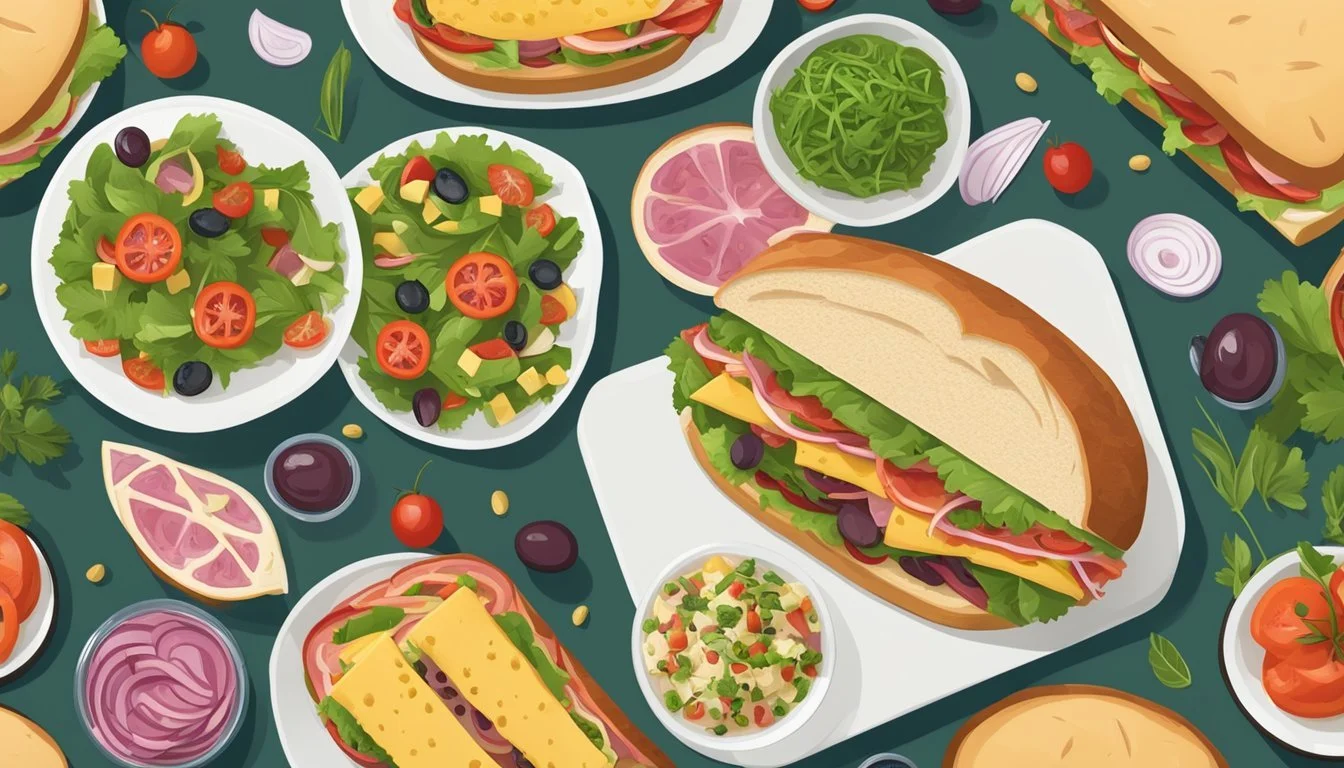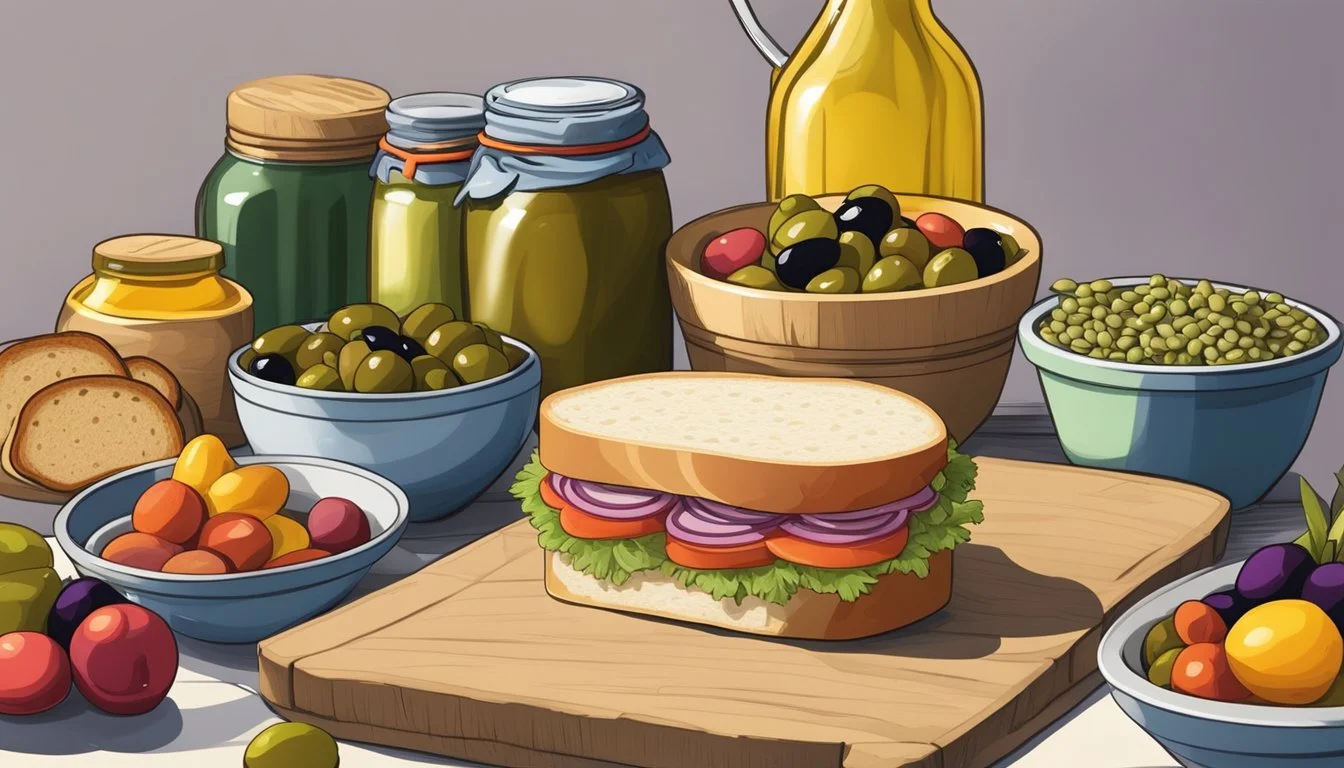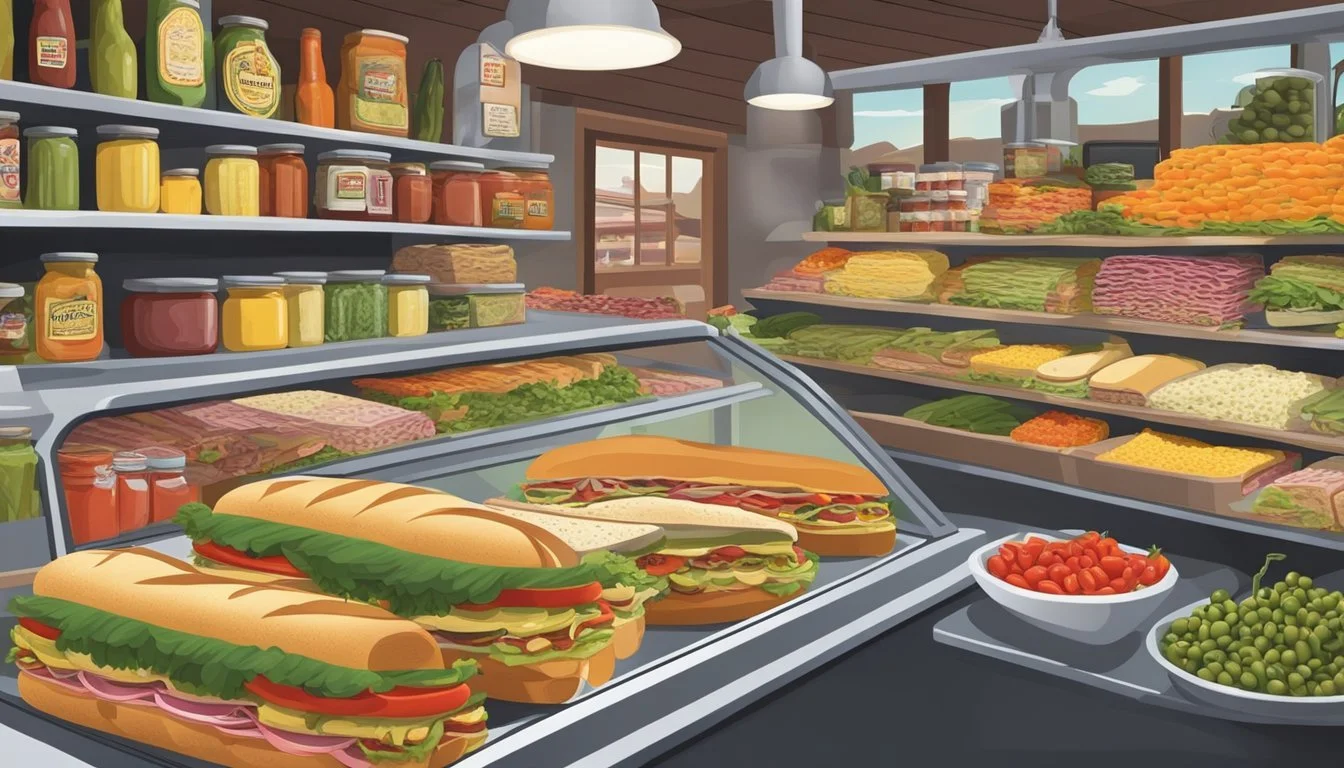Louisiana: The Muffuletta Challenge
A Culinary Quest for Sandwich Lovers
In the heart of Louisiana, a culinary challenge has been quietly simmering, capturing the taste buds and imaginations of food enthusiasts. The Muffuletta, a Louisiana staple, particularly cherished in New Orleans, offers a unique eating experience that combines Italian-inspired ingredients with Southern flair. It's not just a sandwich, it's a hearty, flavor-packed meal with a history nearly as rich as its filling. Traditionally, it stacks a generous amount of Italian cured meats (What wine goes well with cured meats?), cheeses (how long does cheese last?), and a distinctive olive salad, served between the halves of a round, crusty loaf.
The challenge lies not only in crafting the perfect balance of ingredients but also in tackling the sheer size of this iconic sandwich. Baton Rouge has seen residents drive from New Orleans just for a taste of their take on the dish, sometimes featuring a toasted version that adds structure to the sandwich. Meanwhile, events like the Muffuletta Festival in New Orleans celebrate this edible emblem of the city's gastronomic heritage, suggesting it first appeared in the early 1900s.
A symbolic representation of Louisiana's rich culinary culture, the Muffuletta carries the weight of tradition in every bite. Deli meats and creamy cheeses meeting the tangy zip of marinated olives (What wine goes well with olives?) create a symphony of flavors that dance across the palate. The Muffuletta is not just a meal, it's a testament to the melting pot that is Louisiana's food scene, an invitation to embrace the full-bodied character of their local cuisine.
Historical Origins
The muffuletta sandwich has a well-documented lineage that begins in Sicily and blooms to its full form in the bustling French Quarter of New Orleans. Two main entities take center stage in this culinary narrative: the Sicilian origins of the sandwich and Salvatore Lupo, an enterprising Sicilian immigrant who cemented the muffuletta's place in American culinary history.
Sicilian Roots
The muffuletta's inception can be traced back to the Sicilian immigrants who brought their rich culinary traditions to the United States. Central to these traditions was the seed of what would become the muffuletta: a Sicilian sesame bread (What wine goes well with bread?) called "muffuletta." This bread would ultimately serve as the transportive vessel for the plenitude of flavors housed within the famous sandwich.
Salvatore Lupo and Central Grocery
In 1906, Salvatore Lupo, a Sicilian immigrant himself, opened Central Grocery Co. in the French Quarter of New Orleans. Here, Lupo created the muffuletta sandwich by layering meats, cheese, and olive salad into the eponymous bread. Central Grocery became the birthplace of what is now a sought-after staple, touted for its harmonious blend of flavors that meld immigrants’ heritage with local ingredients.
The Muffuletta Sandwich
The Muffuletta Sandwich, originating from New Orleans, is a substantial and flavorful staple. It's crafted using a unique type of bread and is filled with an array of Italian meats and cheeses, all complemented by a distinctive olive salad.
Defining the Muffuletta
The Muffuletta is a hallmark of Louisiana's culinary scene, often associated with the vibrant ambiance of New Orleans. Its key component is the olive salad, a tangy mix typically made with chopped olives, giardiniera, garlic, onions, herbs, and plenty of olive oil. This olive spread is a defining element, showcasing Sicilian influence on the sandwich. The ingredients housed within the bread are a medley of Italian staples—ham, salami, mortadella, and layers of Provolone and mozzarella cheeses which blend harmoniously with the olive salad.
Muffuletta Bread: More Than Just a Loaf
Muffuletta bread is singular in its importance to the integrity of the sandwich. It's a round Italian bread that is dense and sturdy enough to hold the weight of the filling without falling apart. This bread comes sprinkled generously with sesame seeds, which give it a distinctive flavor and texture. The bread's crust possesses a critical crunch, while the interior remains soft, allowing flavors to permeate.
Key Ingredients and Variations
The authentic Louisiana muffuletta is an assemblage of rich meats, varied cheeses, and a distinctive olive salad. Each component is essential to the sandwich’s unique taste and texture.
Cold Cuts Galore
A traditional muffuletta invariably includes a variety of cold cuts. Common selections are mortadella, a rich Italian sausage finely ground and studded with fat and peppercorns; Genoa salami, characterized by its garlic and peppery notes; and capicola, also known as coppa, a spiced and cured meat from the neck or shoulder of the pig. Often, prosciutto, a dry-cured ham known for its delicate taste and buttery texture, is included. These meats are layered in generous proportions to form a meaty foundation for the sandwich.
Cheese: A Mélange of Flavors
The choice of cheese in a muffuletta brings forward a mélange of flavors. Typically, the robust and sharp provolone features prominently, complementing the cured meats with its piquant edge. Swiss cheese, with its mild yet distinct taste, and mozzarella, known for its soft texture, frequently join provolone in creating a trifecta of cheesy goodness that melds delectably when the sandwich is warmed.
The Heart of the Sandwich: Olive Salad
At the heart of the muffuletta lies the olive salad, a critical component imparting a vibrant tanginess which unites the layers of meats and cheeses. It is often a chunky mix of olives, typically including both green olives and kalamata olives, combined with pickled giardiniera (Italian-style pickled vegetables) (What wine goes well with pickled vegetables?) and seasonings. The resulting condiment is not merely an accompaniment but an integral part of the sandwich that inextricably binds all other ingredients.
Constructing the Muffuletta
Creating a Muffuletta requires attention to the quality of bread, precise layering of cold cuts and cheeses, and the masterful use of condiments to achieve the sandwich's signature flavor profile.
Layering Techniques
When constructing a Muffuletta, the sandwich artist begins with a loaf of round, sturdy bread that can hold up to the weight and moisture of the fillings. A classic Muffuletta bread is thick, with a soft interior and a crusty exterior. The builder then adds layers of cold cuts, such as salami, ham, and mortadella. Cheeses come next, often including provolone and mozzarella, each layer carefully placed to ensure even coverage and flavor distribution.
The Role of Condiments
Condiments play a critical role in the Muffuletta's flavor. A generous spread of olive oil or extra-virgin olive oil on the bread adds richness and moisture, while vinegar, such as red wine vinegar, provides a contrasting sharpness and zest. The pièce de résistance is the olive salad, a marinated medley of chopped olives, pickled vegetables, garlic, and herbs that's liberally piled onto the sandwich. This blend ties all the elements together, soaking into the bread and marrying the flavors of the meats and cheeses.
Serving the Muffuletta
The Muffuletta, a New Orleans specialty, is often a focal point at gatherings, pleasing crowds with its distinctive flavor combination. Choosing the right serving temperature and presentation style are critical decisions that can significantly enhance the dining experience.
Temperature Debate: Hot or Cold?
The debate over the ideal way to serve a Muffuletta—warmed or at room temperature—is often lively. Purists argue that a Muffuletta should be served cold, which allows for the full appreciation of the olive salad's zesty profile. On the other hand, toasting the bread can add a pleasing crunch and warmth that contrasts nicely with the cool, marinated filling. Toasting the bread is a practice that some say can add structure to the sandwich, preventing it from crumbling under the heft of its fillings.
Slice and Serve: Presentation Matters
Presentation is paramount when serving a Muffuletta. Typically, the large, round sandwich is divided into quarters or eighths depending on the size and appetite of the guests. Each wedge showcases the layers of meat, cheese, and olive salad, making for an appetizing display. It is essential to balance the arrangement on the platter for visual appeal, as the cross-section of the Muffuletta can be quite striking.
Muffuletta at Home
Crafting a Muffuletta at home allows enthusiasts to bring a taste of Louisiana into their kitchen. The key elements involve preparing a zesty olive salad and assembling the sandwich with precision, using a sturdy bread knife to ensure clean cuts.
Homemade Olive Salad
An authentic Muffuletta is distinguished by its olive salad, a mixture that should be prepared in advance to allow the flavors to meld. One combines chopped olives, giardiniera, peppers, parsley, capers, (What wine goes well with capers?) and garlic in a food processor. After pulsing the mixture to achieve the desired chunkiness, it is usually best to let the olive salad rest overnight.
Ingredients:
1 cup mixed olives, pitted and chopped
1/2 cup giardiniera, chopped
1/4 cup pickled peppers, chopped
2 tablespoons capers, rinsed and drained
1/4 cup flat-leaf parsley, finely chopped
3 cloves garlic, minced
Instructions:
Place all ingredients in a food processor.
Pulse until coarsely chopped, not pureed.
Mix in 1/3 cup olive oil and a splash of vinegar.
Transfer to a nonreactive container and refrigerate overnight.
Assembling Your Own Muffuletta
Once the olive salad is infused with flavor, one is ready to assemble their Muffuletta. A large, round loaf of bread, preferably sesame-studded, is sliced horizontally with a bread knife. The inside is then layered with Italian cured meats, provolone cheese, and a generous helping of the olive salad.
Assembly:
Slice the bread in half horizontally.
Brush the cut sides with the remaining garlic oil from the olive salad.
Distribute the olive salad evenly on the bottom half of the bread.
Layer on salami, ham, mortadella, and provolone cheese.
Cap with the top half of the bread and press down gently.
One can then slice the Muffuletta into wedges to serve, ensuring each piece includes all layers of this iconic recipe. Enjoying it at home allows for a personalized touch, adjusting ingredients to taste for a satisfying meal.
Beyond the Classic
In Louisiana, the muffuletta is not just a sandwich; it's a tradition. Yet, chefs and food enthusiasts are reimagining this New Orleans classic, leading to creative variations that honor its heritage while steering its flavors in new directions.
Innovative Twists and Variations
Restaurants across New Orleans have been experimenting with the muffuletta, introducing innovative twists to this classic sandwich. Some push the boundaries by altering the traditional ingredients, like substituting the customary meats with artisanal charcuterie or local sausages, while others experiment with cheeses that range from aged provolone to smoked gouda. Additionally, bold chefs are switching up the signature olive salad, incorporating elements such as sun-dried tomatoes and roasted red peppers for a modern take.
Bread Changes: While the classic round seeded loaf is sacred, alternatives such as focaccia or ciabatta are being used, giving the sandwiches (What wine goes well with sandwiches?) an Italian twist that still feels very much in line with the original.
Vegetarian Options: There are even variations catering to vegetarians, swapping out the meats for grilled vegetables, but keeping that all-important olive salad.
Muffuletta-inspired Dishes
One might wonder how far the muffuletta can inspire. Chefs are not merely stopping at sandwiches but introducing an entirely new array of muffuletta-inspired dishes. For instance, some eateries offer muffuletta pizzas, taking the core components of the sandwich and repurposing them into a delectable and sociable pizza topping.
Salads: (What wine goes well with salads?) A deconstructed muffuletta salad featuring all the flavors of the sandwich—olives, cheese, meats—tossed with fresh greens is making appearances on menus.
Pastas: There's even muffuletta pasta, incorporating the olive mix and cured meats into a pasta salad that has that muffuletta essence in every bite.
These innovative dishes prove that the flavors of the muffuletta are versatile enough to transcend their sandwich origins, bringing the essence of New Orleans to an array of new culinary experiences.
Culture and Community Impact
The Muffuletta has firmly entrenched itself within Louisiana's cultural tapestry, celebrating and shaping the community and food scene, particularly in New Orleans. Festivals dedicated to the iconic sandwich highlight its importance to the region's cultural identity.
Festivals and Culinary Events
The love for the Muffuletta manifests in vibrant and flavorful festivals, such as the Muffuletta Festival in New Orleans. This festival, much like a block party, brings the community together on weekends with a shared appreciation for one of their most famous culinary creations. Festivities not only promote local businesses but also foster a sense of unity among attendees through the universal language of food.
The Sandwich's Role in New Orleans' Identity
The Muffuletta is more than just a sandwich; it's a symbol of New Orleans' Sicilian heritage and culinary innovation. Institutions like the Central Grocery Co. have been carving up Muffulettas for over a century, marking them as an indelible part of the city's identity. As a culinary touchstone, it reflects the city's ability to blend cultures, creating a food scene that is distinct and emblematic of New Orleans' broader cultural mosaic.
Finding the Authentic Experience
When one seeks the authentic Muffuletta experience, they are not just looking for a sandwich; they're entering a culinary tradition steeped in New Orleans culture. It requires visiting the locales where history and taste intersect in the most delicious ways.
Best Spots in New Orleans
New Orleans, a city rich with gastronomic history, is home to the Muffuletta, a sandwich that is as much a part of the city's fabric as jazz and beignets. Visitors should beeline to the French Quarter, the birthplace of the Muffuletta, where they can taste the original creation.
Central Grocery & Deli: Often credited with inventing the Muffuletta, this deli is a must-visit for the sandwich purists.
Other Notable Spots:
Liuzza's by the Track
Cochon Butcher
Napoleon House
Each location offers its own twist on the classic, allowing visitors to immerse themselves in a variety of authentic flavors.
Delis and Local Favorites
Beyond the French Quarter, several delis and local favorites have mastered the art of the Muffuletta, marrying local charm with hearty, Italian-inspired fare.
Local Delis:
Frank's Restaurant
DiMartino's Famous New Orleans Muffulettas
Nor-Joe Importing Co.
These establishments serve not only fantastic Muffulettas but also embody the spirit of New Orleans's hospitable and flavorful charm. Visitors may find each deli offers a different atmosphere, whether it's a cozy corner spot or a bustling eatery with a long history.








